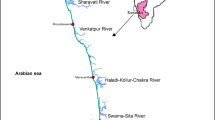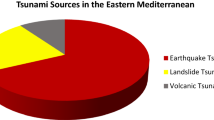Abstract
Recent occurrences of catastrophic events of coupled ground motions and tsunami waves have raised concerns about the need for comprehensive tsunami mitigation planning. In this field, the quantification of tsunami waves, which can be obtained from tsunami hazard assessment, is an important data. The results of tsunami hazard assessments show the intensity of the impact on a coastal area versus its return period. This study performs probabilistic tsunami hazard assessment (PTHA) in Lhoknga coastline, Aceh, Indonesia. PTHA employs information about earthquake-caused tsunami faults and their return period. The generation, propagation, and inundation of tsunami waves on the coastline are simulated using available tsunami numerical simulation. In addition, smoothed particle hydrodynamic (SPH) method is used to observe the spread of tsunami flood on the dry land. This open new opportunity to assess tsunami flooding hazard within a probabilistic environment.
Access this chapter
Tax calculation will be finalised at checkout
Purchases are for personal use only
Similar content being viewed by others
References
Cho YS (1995) Numerical simulations of tsunami propagation and run-up. Cornell University
Crespo AJ, Domínguez JM, Rogers BD, Gómez-Gesteira M, Longshaw S, Canelas R, García-Feal O (2015) DualSPHysics: open-source parallel CFD solver based on Smoothed Particle Hydrodynamics (SPH). Comput Phys Commun 187:204–216
Geist EL, Lynett PJ (2014) Source processes for the probabilistic assessment of tsunami hazards. Oceanography 27(2):86
Geist EL, Parsons T (2006) Probabilistic analysis of tsunami hazards*. Nat Hazards 37(3):277–314
Gutenberg B, Richter CF (1944) Frequency of earthquakes in California. Bull Seismol Soc Am 34(4):185–188
Hess R (2007) The essential Blender: guide to 3D creation with the open source suite Blender. No Starch Press
Imamura F, Shuto N, Goto C (1988) Numerical simulations of the transoceanic propagation of tsunamis. In: Sixth congress of the Asian and pacific regional division. International Association of Hydraulic Research, Kyoto, Japan
Kawata Y, Tsuji Y, Sugimoto Y, Hayashi H, Matsutomi H, Okamura Y, Hayashi I, Kayane H, Tanioka Y, Fujima K, Imamura F (2005) Comprehensive analysis of the damage and its impact on coastal zones by the 2004 Indian Ocean tsunami disaster. Disaster Prevention Research Institute. http://www.tsunami.civil.tohoku.ac.jp/sumatra2004/report.html
Monaghan JJ (1992) Smoothed particle hydrodynamics. Ann Rev Astron Astrophys 30:543–574
Thio HK, Somerville P (2009) A probabilistic tsunami hazard analysis of California. In: TCLEE 2009@ sLifeline earthquake engineering in a multihazard environment. ASCE, pp 1–12
Shuto N (1991) Numerical simulation of tsunamis—its present and near future. Nat Hazards 4(2–3):171–191
Wang X, Liu PLF (2006) An analysis of 2004 Sumatra earthquake fault plane mechanisms and Indian Ocean tsunami. J Hydraul Res 44(2):147–154
Wang X (2009) User manual for COMCOT version 1.7 (first draft). Cornel University, 65
Wells DL, Coppersmith KJ (1994) New empirical relationships among magnitude, rupture length, rupture width, rupture area, and surface displacement. Bull Seismol Soc Am 84(4):974–1002
Acknowledgments
This work was supported by the year of 2012–2013 Research Funds of the Ulsan National Institute of Science and Technology (UNIST).
Author information
Authors and Affiliations
Corresponding author
Editor information
Editors and Affiliations
Rights and permissions
Copyright information
© 2017 Springer International Publishing AG
About this paper
Cite this paper
Sihombing, F., Torbol, M. (2017). Probabilistic Tsunami Hazard Assessment Through Large Scale Simulations. In: Caspeele, R., Taerwe, L., Proske, D. (eds) 14th International Probabilistic Workshop . Springer, Cham. https://doi.org/10.1007/978-3-319-47886-9_20
Download citation
DOI: https://doi.org/10.1007/978-3-319-47886-9_20
Published:
Publisher Name: Springer, Cham
Print ISBN: 978-3-319-47885-2
Online ISBN: 978-3-319-47886-9
eBook Packages: EngineeringEngineering (R0)




